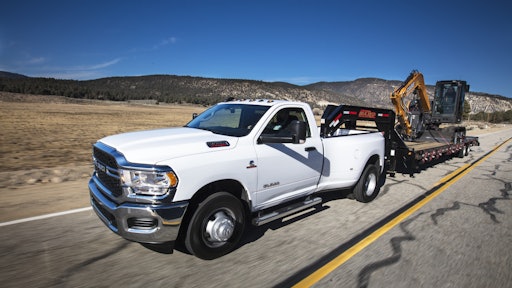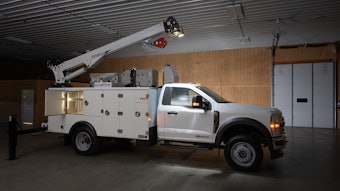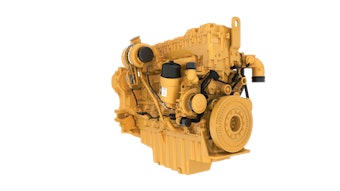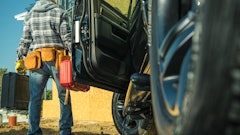
Technology advances promise to reduce the stress and increase safety when hitching and pulling equipment trailers with your pickup truck. Cameras, radar, integrated trailer brakes and tire pressure monitoring systems are all becoming more popular.
Large in-dash screens in current generation pickup trucks provide several camera views which make backing up to and connecting a trailer a one-person operation. It eliminates the guesswork when backing up to the trailer hitch. The camera pointed at the pickup trailer hitch ensures perfect alignment every time.
Rear visibility when pulling the trailer down the road or backing into tight spaces can be simplified with trailer-mounted auxiliary cameras. Such devices are currently offered by both Ram Trucks and General Motors.
Trailer Safety: New Camera Views Reduce Blind Spots
Ram Heavy Duty pickups feature a cargo-view camera to monitor payload in the bed. This camera can also be used to align fifth-wheel and gooseneck trailers with grid lines. A 360-degree surround-view camera with trailer reverse guidance view provides a single display-screen view of both sides of a trailer to assist drivers in maneuvering towing setups. An auxiliary exterior camera improves visibility with custom positioning in and behind trailers. There are also cameras in the mirrors and when you are pulling a trailer you can get a split pane view on the 12 in. center console screen that shows each side of the trailer for backing into tight spaces or next to buildings. Spotter lights in the mirrors allow visibility down the sides of the trailer in low-light conditions.
General Motors recently introduced camera technology that provides several unique views. The 2020 Silverado HD and GMC Sierra HD offer up to 15 unique camera views, including HD Surround Vision, Bed View and an industry-first transparent trailer view. The transparent trailer feature uses the tailgate-mounted camera and an available accessory camera mounted on the rear of the trailer. The resultant image allows the driver to virtually see through the trailer, a benefit when navigating parking lots, merging into traffic or when making a tight turn.
Other views, including Rear Side View and Bowl View also enhance the towing experience. Rear Side View shows the rear sides of the vehicle to help allow the driver to view objects near the vehicle. Bowl view provides rear-facing 3D surround view that gives a sense of the height of objects surrounding the vehicle while backing.
Backing trailers into tight spaces can prove challenging to some drivers. Ford simplifies this task with Pro Trailer Backup Assist. A knob mounted near the reverse camera allows drivers to easily steer the trailer with hands off the steering wheel. The truck’s Trailer Reverse Guidance system shows trailer angle and direction, and provides steering suggestions to most efficiently direct a trailer backward. Both systems are built to accommodate all trailer styles, including fifth wheel and gooseneck trailers.
Trailer Safety: Collision Avoidance Adapts for Towing
Collision avoidance technologies also help keep drivers safe while towing. For instance, Ford adapted its Blind Spot Information System (BLIS) to include the trailer being towed. The BLIS monitors for vehicles in your blind spots, even when towing.
The Ram 3500 dual rear wheel pickup includes specifically designed sensors to cover the added width of dual rear wheels, giving a wider span of coverage when backing up with limited view.
Trailer Safety: Don’t Exceed Truck or Trailer Capabilities
Beyond visibility issues, safe towing requires an understanding of trailer and tow vehicle capabilities. Often the weight of equipment to be transported is miscalculated, resulting in overloading the truck and trailer. Each vehicle manufacturer assigns a tow rating, which is the maximum weight of the tow vehicle when loaded.
Make sure your tow vehicle is up to the task. The tow vehicle’s hitch rating should meet or exceed the GVWR of the trailer you’re towing. This applies to the receiver hitch itself, as well as the ball mount and ball or pintle hitch assembly.
Similarly, the trailer’s gross vehicle weight rating (GVWR) is printed on a label or placard - often referred to as the certification or VIN label - mounted on the left front side of the trailer, typically within 6 inches of the floor line or near the coupler. The GVWR is the maximum a trailer should ever weigh when loaded.
The trailer gross axle weight rating (GAWR) is also listed on the certification label. According to the Trailer Safety Industry Coalition (TISC), this indicates the most weight an axle can bear. If the trailer has more than one axle, each axle will have weight rating information provided on the certification label.
The construction of the trailer also deserves close examination. Not all trailers are constructed the same. Make sure there are sufficient crossmembers underneath the trailer to support the specific load you plan to haul. A 7,000-lb. GVW car hauler trailer may not be appropriate for a skid-steer loader. Even though the overall weight capacity may be sufficient, the trailer is not designed for the weight loading produced by that piece of equipment. A car has a more dispersed weight where some construction equipment can produce very concentrated weight loading on the trailer.
Note that trailers have a speed rating. Manufacturers usually state a 55- or 65-mph rating. The slower a rig travels, the less added weight or stress is placed on the trailer. The key is to select a unit that will perform at a fleet’s normal operating speed.
Trailer Safety: Load the Trailer Properly
Weight distribution on a trailer is critical to safe performance. Too much of the load on the front is going to cause the tow vehicle to be unstable and it may cause under-steer or jackknifing. Too much on the back it lifts the rear end of the tow vehicle, which causes trailer instability and swaying. The tow vehicle needs to be level. The front end of the truck should come back down to a level position.
The hitch height is critical in ensuring that the trailer tows properly according to Felling Trailers. As a rule, when on a flat, level loading surface, the trailer should be higher in the front than the rear, so that when the trailer is fully loaded, the truck and trailer are sitting level.
Don't put excessive weight on the trailer tongue. A 10% to 15% tongue weight is common for bumper pull trailers and 20% to 25% for goosenecks and fifth wheels. Under-loaded or negative tongue weight is worse than excessive tongue weight, and could cause loss of control according to Felling Trailers.
Take the time initially to understand where the equipment should be loaded. You may want to put a stop on the trailer. This could be a piece of angle iron that tells the operator where the vehicle being loaded needs to stop. It can be made to clip on so it can be easily removed if you need to move other equipment.
In addition, don't place excessive weight on either side of the trailer. If you do, the tire weight ratings on the heavy side will likely be exceeded and the trailer will not handle correctly.
Even when properly loaded, a trailer will change vehicle dynamics. Any time a trailer is added to the back of a vehicle — no matter the size — there is going to be a significant degradation in the vehicle’s performance, whether it’s acceleration, braking, handling or stability.





























